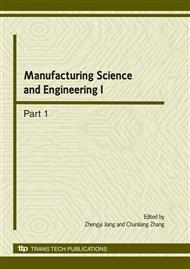p.1181
p.1186
p.1194
p.1198
p.1203
p.1207
p.1212
p.1216
p.1223
Study on the Mechanism of the Cobalt Leaching of Cemented Carbide in Triethanolamine Solution
Abstract:
The reactionary trend of the triethanolamine and cobalt in cemented carbide and the mechanism of cobalt leaching have been investigated by soaking experiments, friction experiments and electrochemical gaging experiments. The experimental results reveal that triethanolamine is prone to form coordination compound with cobalt ion .The amount of cobalt’s element leaching from cemented carbide is added up with the increase of time and triethanolamine concentration. So when using cemented carbide cutting tool, the water-based cutting fluid containing triethanolamine addictive should be avoided.
Info:
Periodical:
Pages:
1203-1206
Citation:
Online since:
March 2010
Authors:
Price:
Сopyright:
© 2010 Trans Tech Publications Ltd. All Rights Reserved
Share:
Citation:


